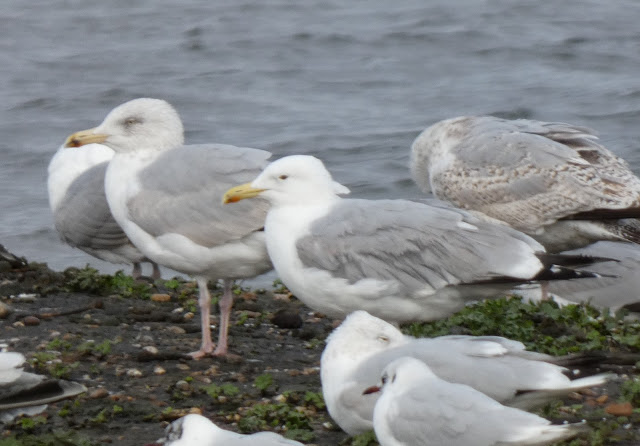Wildlife sightings for 19th July 2013
1 Oystercatcher - main lake shingle ridge
2 Lapwing chicks - wader scrape
2 Little Grebe chicks - main lake, sheltered lagoon
Green woodpecker family - South route (at least 2 juv's)
2 Peregrine - perched on hospital
Recent bird highlights: Black-necked Grebe, Little Egret, Peregrine, Red Kite, Hobby, Buzzard, Shelduck, Dunlin, Redshank, Green Sandpiper, Common Sandpiper, Little Ringed Plover, Snipe, Red-backed Shrike.
There are several broods of Lapwing and Redshank chicks on the marsh, main lake and wader scrape. They are becoming increasingly hard to spot as the tall grasses and herbs grow up around them, giving them better cover from avian predators like Lesser Black-backed Gulls and Carrion Crow. Many of the early Redshank and Lapwing chicks have now fledged. Tufted Duck, Pochard, Mallard, Gadwall and Little Grebe all have nests and young on the lake islands and amongst the marginal vegetation. Mute Swan have successfully raised 5 broods of cygnets (much higher than previous years). The Sand Martins first brood young have already fledged, many of them sitting on the electric wires around the marsh, and some of the adult Sand Martin are now sitting on eggs for the second time.
Black-headed Gulls and Common Terns have had several broods between them and continue to co-exist with each other out on the purpose-built rafts on the main lake and resr lagoon. Both species are very aggressive towards avian predators and will freely fly up to meet attacking Lesser Black-backed Gulls, Grey Herons and Carrion Crow. These Black-headed Gulls and Terns also provide some free air cover for the breeding waders that nest nearby.
Other young birds around at the moment include Whitethroats (1 brood), Chiffchaff (1 brood), Goldcrest (2 broods), and plentiful numbers of Blue Tit, Great Tit, Robin, Blackbird, Wren, Dunnock, Reed Warbler, Great Spotted Woodpecker.
Butterflies and other invertebrates: Common Blue, 5-Spot Burnet Moth, Small Tortoishell, Comma, Brimstone, Small White, Large White, Speckled Wood, Green-veined White, Small Copper, Large Skipper, Small Skipper, Grizzled Skipper, Azure/Common Blue Damselfly, Blue-tailed Damselfly, Hairy Dragonfly, Large Red Damselfly, Emperor Dragonfly, Broad-bodied Chaser, Southern Hawker, Black-tailed Skimmer, Banded Demoiselle.
Water voles: actively feeding in the Wildside ponds in particular (listen out for the very audible munching from the base of marginal aquatic plants like Branched Bur-reed and Greater Pond Sedge). They also often make a distinctive ‘plop’ sound as they leap into the water from the channel edge.
Reptiles: Common Lizards have been seen on log piles on the South Route and pond zone; also around the brick edges of the sluices if quiet enough. Slow Worms are present below the survey tins and sometimes basking on habitat piles. Grass Snakes may be spotted swimming across ponds in wildside.
Flowering plants: Bee Orchid, Bittersweet, Black Medick, Bladder Campion, Blue Water-speedwell, Branched Bur-reed, Cat’s-ear, Charlock, Chives, Columbine, Common Chickweed, Common Mallow, Common Sorrel, Common Spotted Orchid, Crow Garlic, Goat’s Beard, Curry Plant, Cut-leaved Crane’s-bill, Deptford Pink, Field Scabious, French Sorrel, Fuchsia, Garden Geranium / Crane’s-bill varieties, Lady’s-mantle, Globe Flower, Grass Vetchling, Great Bird’s-foot Trefoil, Great Burnet, Hedgerow Crane’s-bill, Hemlock Water-dropwort, Hoary Plantain, Hop Trefoil, Lavender, Lesser Swinecress, Love-in-the-Mist, Mare’s-tail (plants have emerged out of water – flowers are tiny and in whorl around stem), Meadow Buttercup, Meadow Clary, Meadow Vetchling, Oriental Poppy, Peony, Pineapple Mayweed, Procumbent Pearlwort, Purple Toadflax, Ragged Robin, Red Campion, Red Clover, Round-leaved Crane’s-bill, Sage, Scented Mayweed, Scentless Mayweed, Short-fruited Willowherb, Smooth Tare, Smooth Hawk’s-beard, Southern Marsh Orchid, Spotted Medick, Sweet Flag, Welsh Poppy, White Clover, Wild Clary, Wild Strawberry, Wild Thyme, Yellow Iris, Yellow Rattle, Yellow Water-Lily.
Fungi: Brittlegill species on birch trees (e.g. Bleached Brittlegill), Brown Mottlegill, Firerug Inkcap, Hare’s-foot Inkcap, Lycogala terrestre (a slime mould), Palamino Cup, Pleated Inkcap species, Spring Fieldcap, Trichia persimilis (possible) (a slime mould), Yellow Brain.
Grasses, Sedges & Rushes: Common Club-rush, Common Spike-rush, Crested Dog’s-tail, Crested Hair-grass, False Oat-grass, Fern-grass, Hairy Brome, Meadow Oat-grass, Perennial Rye-grass, Quaking-grass, Tufted Hair-grass, Yellow Oat-grass, Yorkshire Fog, Wood Club-rush.



